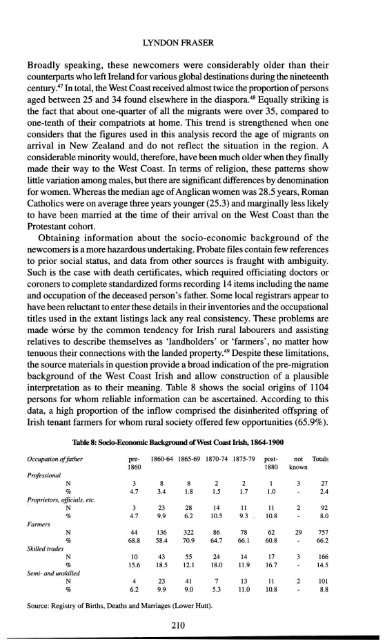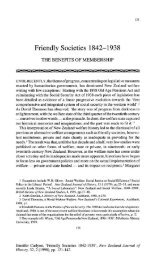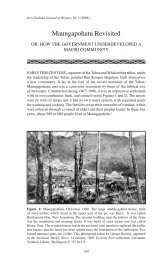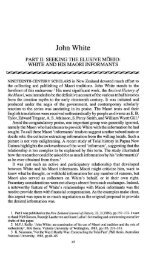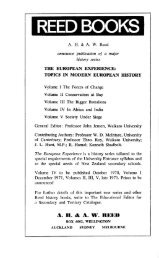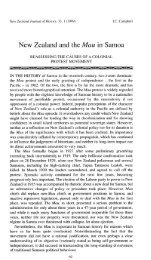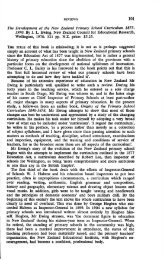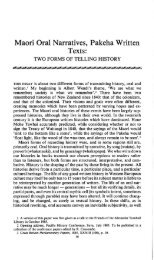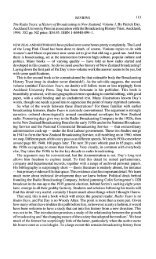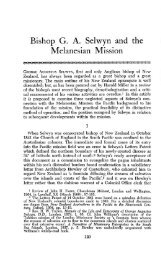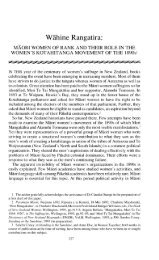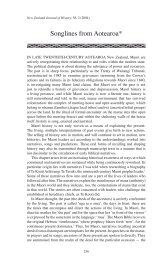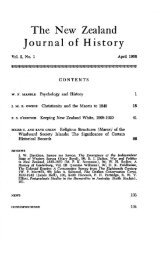Irish Migration to the West Coast, 1864-1900 - New Zealand Journal ...
Irish Migration to the West Coast, 1864-1900 - New Zealand Journal ...
Irish Migration to the West Coast, 1864-1900 - New Zealand Journal ...
Create successful ePaper yourself
Turn your PDF publications into a flip-book with our unique Google optimized e-Paper software.
LYNDON FRASER<br />
Broadly speaking, <strong>the</strong>se newcomers were considerably older than <strong>the</strong>ir<br />
counterparts who left Ireland for various global destinations during <strong>the</strong> nineteenth<br />
century. 47 In <strong>to</strong>tal, <strong>the</strong> <strong>West</strong> <strong>Coast</strong> received almost twice <strong>the</strong> proportion of persons<br />
aged between 25 and 34 found elsewhere in <strong>the</strong> diaspora. 48 Equally striking is<br />
<strong>the</strong> fact that about one-quarter of all <strong>the</strong> migrants were over 35, compared <strong>to</strong><br />
one-tenth of <strong>the</strong>ir compatriots at home. This trend is streng<strong>the</strong>ned when one<br />
considers that <strong>the</strong> figures used in this analysis record <strong>the</strong> age of migrants on<br />
arrival in <strong>New</strong> <strong>Zealand</strong> and do not reflect <strong>the</strong> situation in <strong>the</strong> region. A<br />
considerable minority would, <strong>the</strong>refore, have been much older when <strong>the</strong>y finally<br />
made <strong>the</strong>ir way <strong>to</strong> <strong>the</strong> <strong>West</strong> <strong>Coast</strong>. In terms of religion, <strong>the</strong>se patterns show<br />
little variation among males, but <strong>the</strong>re are significant differences by denomination<br />
for women. Whereas <strong>the</strong> median age of Anglican women was 28.5 years, Roman<br />
Catholics were on average three years younger (25.3) and marginally tess likely<br />
<strong>to</strong> have been married at <strong>the</strong> time of <strong>the</strong>ir arrival on <strong>the</strong> <strong>West</strong> <strong>Coast</strong> than <strong>the</strong><br />
Protestant cohort.<br />
Obtaining information about <strong>the</strong> socio-economic background of <strong>the</strong><br />
newcomers is a more hazardous undertaking. Probate files contain few references<br />
<strong>to</strong> prior social status, and data from o<strong>the</strong>r sources is fraught with ambiguity.<br />
Such is <strong>the</strong> case with death certificates, which required officiating doc<strong>to</strong>rs or<br />
coroners <strong>to</strong> complete standardized forms recording 14 items including <strong>the</strong> name<br />
and occupation of <strong>the</strong> deceased person's fa<strong>the</strong>r. Some local registrars appear <strong>to</strong><br />
have been reluctant <strong>to</strong> enter <strong>the</strong>se details in <strong>the</strong>ir inven<strong>to</strong>ries and <strong>the</strong> occupational<br />
titles used in <strong>the</strong> extant listings lack any real consistency. These problems are<br />
made worse by <strong>the</strong> common tendency for <strong>Irish</strong> rural labourers and assisting<br />
relatives <strong>to</strong> describe <strong>the</strong>mselves as 'landholders' or 'farmers', no matter how<br />
tenuous <strong>the</strong>ir connections with <strong>the</strong> landed property. 49 Despite <strong>the</strong>se limitations,<br />
<strong>the</strong> source materials in question provide a broad indication of <strong>the</strong> pre-migration<br />
background of <strong>the</strong> <strong>West</strong> <strong>Coast</strong> <strong>Irish</strong> and allow construction of a plausible<br />
interpretation as <strong>to</strong> <strong>the</strong>ir meaning. Table 8 shows <strong>the</strong> social origins of 1104<br />
persons for whom reliable information can be ascertained. According <strong>to</strong> this<br />
data, a high proportion of <strong>the</strong> inflow comprised <strong>the</strong> disinherited offspring of<br />
<strong>Irish</strong> tenant farmers for whom rural society offered few opportunities (65.9%).<br />
Table 8: .Socio-Economic Background of <strong>West</strong> <strong>Coast</strong> <strong>Irish</strong>, <strong>1864</strong>-<strong>1900</strong><br />
Occupation of fa<strong>the</strong>r pre- 1860-64 1865-69 1870-74 1875-79 post- not Totals<br />
1860 1880 known<br />
Professional<br />
N 3 8 8 2 2 1 3 27<br />
% 4.7 3.4 1.8 1.5 1.7 1.0 2.4<br />
Proprie<strong>to</strong>rs, officials, etc.<br />
N 3 23 28 14 11 11 2 92<br />
% 4.7 9.9 6.2 10.5 9.3 10.8 8.0<br />
Farmers<br />
N 44 136 322 86 78 62 29 757<br />
% 68.8 58.4 70.9 64.7 66.1 60.8 - 66.2<br />
Skilled trades<br />
N 10 43 55 24 14 17 3 166<br />
% 15.6 18.5 12.1 18.0 11.9 16.7 14.5<br />
Semi- and unskilled<br />
N 4 23 41 7 13 11 2 101<br />
% 6.2 9.9 9.0 5.3 11.0 10.8 - 8.8<br />
Source: Registry of Births, Deaths and Marriages (Lower Hutt).<br />
210


